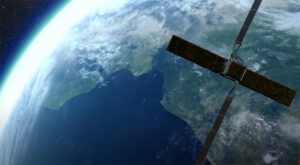As our climate changes, ice sheets on land shrink and ice covering the sea breaks up. Frozen lands change shape as permafrost in the soil melts. The Arctic is warming twice as fast as the rest of Earth and the changes are accelerating.
While the rest of the world fears rising sea levels, the warming Arctic is opening new shipping routes that promise to cut travel times. New fishing grounds will help feed the world, and new mineral deposits may supply the next generation of electric cars and wind turbines.
Hidden Perils
Yet the hazards of the Arctic remain. The more people who journey there, the greater the risks to life, health and commerce.
That’s why a company called Kongsberg Satellite Services or KSAT is working to monitor Arctic weather and sea ice from space. They use a technology called Synthetic Aperture Radar that can see through darkness and clouds and accurately measure features on the sea surface and terrain, like the gaps separating ice and sea. It gives governments, cruise lines, and energy companies timely information about icebergs and shifting coastlines to prevent shipwrecks and speed journeys.
For more than 20 years, KSAT has been providing detection of oil spills from space, turning satellite images into actionable data in 120 minutes or less. That fast detection means less impact on the environment and lower costs for clean-up.
Algae is a natural part of sea water. But when conditions are right, it can bloom into big, toxic masses. In 2019, an algae bloom off Norway struck fish farms, killing nearly 8 million salmon. KSAT is now supporting a satellite mission for a Norwegian university, testing the use of a technology called hyperspectral imaging to distinguish toxic blooms from harmless growth.
KSAT offers a ground monitoring service called inSAR in partnership with European companies. It tracks movements in the Earth’s surface down to the millimeter for scientists, governments, insurers, and investors. As the world keeps warming, seeing how the land changes over time will become critical to helping us adapt.
Surviving Extremes
And we need to adapt. In 2019, the extreme adventurer Mike Horn and polar explorer Borge Ousland began crossing the Arctic on foot. As they neared the end of their perilous journey, the ship that was supposed to pick them up got stuck in the shifting ice. Two other explorers set out on skies from the ship to reach them, bringing food and supplies. Temperatures were high, and deep crevices began to open in the ice, separating the two parties. But, analyzing high-resolution satellite images, KSAT experts steered the adventurers to safety over a satellite phone. After 87 days on the ice, Horn and Ousland reached their ship, which finally broke free.
Our planet will keep changing in unexpected ways in the years ahead. Risk of extreme heat and cold, fierce storms, and wildfires will increase. Rising to that challenge will take courage, ingenuity, and foresight. We will also need insights on our planet that can only come from satellite technology and innovators like KSAT.
wildfires will increase. Rising to that challenge will take courage, ingenuity, and foresight. We will also need insights on our planet that can only come from satellite technology and innovators like KSAT.
Produced for SpaceNews by Space & Satellite Professionals International
See more stories and videos of satellite making a better world at www.bettersatelliteworld.com



